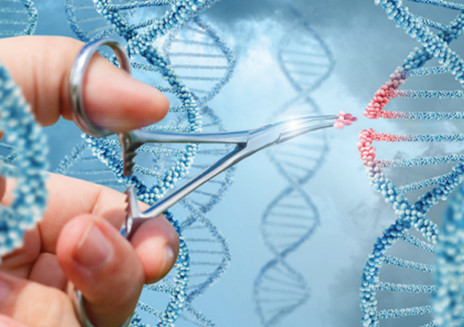




 |
 |
 |
|||
 |
 |
 |
 |
 | |
 |
 |
 | |


| 미디어 브리핑스 | 내서재담기 |


  |
 |  |
기술 발전이 가속화되면서, 급격한 경제 전환 국면의 시대가 열렸다. 닷컴 붕괴 이후 시작된 이 양상은 앞으로 20년 간 세상을 혁명적으로 탈바꿈할 것 같다.
이 혁명적 변화를 이끄는 가장 중요한 기술들 중 주목해야 할 3가지가 있다. 바로 유전체학Genomics, 바이오 리엔지니어링Bioreengineering 그리고 합성 생명Synthetic Life이다. 이 기술들은 60년 이상의 과거부터 빠르게 가속화된 연구와 학습 과정의 결과다.
우리는 1950년대 유전자 코드의 기본과 기초를 이해하기 시작했고, 1970년대에 이르러 인위적으로 DNA 조각을 읽고 유전자를 연결할 수 있었다. 1990년대는 10억 달러가 넘는 비용을 들여 인류 역사 최초로 인간 게놈의 배열 순서를 밝히는 데 성공했다. 신의 영역을 엿보기 시작한 것이다. 그리고 2000년대에 이르러 우리는 그 과정을 일반적인 것으로 치환했고, 비용을 극적으로 줄이기 시작했다.
그러나 이 기술을 치료에 활용하는 데 있어, 가장 큰 문제들 중 하나는 유전자 편집에 있어서의 높은 실패율이었다.
이후 불과 5년 전, 캘리포니아대학교 버클리 캠퍼스의 생화학자 제니퍼 다우드나Jennifer Doudna와 프랑스 미생물학자 엠먀뉴엘 샤펜티어Emmanuelle Charpentier는 ‘크리스퍼 카스나인CRISPR Cas9’라는 새로운 기술로 생물학계를 깜짝 놀라게 만들었다. 이 기술은 유전자 편집 오류 문제를 본질적으로 해결하고 수없이 많은 새로운 가능성을 열어줬다. 크리스퍼 카스나인이 〈사이언스Science〉지에 처음 발표되자, 인류가 오랫동안 기대했던 순간을 맞이했다고 느꼈다. 인간이 사상 최초로 스스로 생명공학자가 될 수 있었던 것이다.
크리스퍼 카스나인은 마이크로소프트 워드 프로그램의 ‘검색 및 변경’ 기능처럼 과학자들이 유전자의 특정 영역을 목표로 삼아 그 기능을 찾고 치환해주는 것을 가능하게 하는 도구다. 즉 원하지 않는 영역을 제거하고 그 자리에 원하는 염기서열sequence을 넣는 것이다.
상업적 권리에 대한 계속되는 법적 분쟁에도 불구하고, 크리스퍼 카스나인은 인간과 다른 생물체에서 유전자를 변형하고자 하는 사람들에게 점점 더 필수 선택 도구가 되고 있다. 무엇보다도, 이것은 다음과 같은 실험에 사용되었다.
- 말라리아에 저항성 있는 모기 만들기
- 질병에 저항성 있도록 식물에 유전자변형 시키기
- 유전자 조작된 애완동물 혹은 생물의 가능성 탐구하기
- 혈우병과 백혈병을 포함하여 잠재적으로 인간의 질병 치료하기
그러나 크리스퍼 카스나인은 아직 초기 단계에 있다. 여전히 해결해야 할 일반적인 안전 문제는 의도된 위치에서 벗어난 DNA 구역에서 종종 발생한다. 즉, ‘목표를 벗어난’ 편집의 가능성에 있다. 과학자들은 크리스퍼 카스나인을 미세 조정하면 이 문제를 해결할 수 있다고 믿지만, 실제로 이런 문제가 사람에게 일어난다면 그것은 아주 치명적일 수 있다.
크리스퍼 카스나인을 발견한 다우드나는 이 도구의 긍정적 잠재력에 전율하면서도 이것이 악용될 수 있다는 점도 동시에 우려하고 있다. 이러한 두려움으로 인해 다우드나는 연구자들이 다양한 가능성에 심취하더라도 세계는 이 도구의 잠재적 단점을 확실하게 인지하도록 하는 데 노력을 기울이고 있다.
예를 들어, 다우드나는 크리스퍼 카스나인이 인간의 정자, 난자, 배아에서의 소위 ‘생식 세포’를 편집하여 ‘설계된 인간’을 창조하는 데 사용될 수 있다고 두려워한다. 이러한 변경은 태아에게 그대로 적용되어 훗날 태어날 후손들에게도 전달될 것이다. 이로 인해 예측할 수 없는 결과가 초래될 수도 있다.
2015년 다우드나는 워싱턴 D.C.에서 20개국 500명의 과학자, 윤리학자 및 기타 관계자들이 참석한 정상회의를 주도했다. 이 회의는 크리스퍼 카스나인에게 끔찍한 질병을 편집하는 데 사용될 수 있는 한정된 경우에만 - 그리고 다양한 윤리와 안전 문제가 해결된 이후에 - 생식 세포의 편집을 허용하자는 조직위원회의 성명서 발표로 마무리되었다.
더 최근에는 국립과학아카데미National Academy of Sciences가 소집한 국제위원회가 인간 생식세포 유전자 편집에 대해 우려에 중점을 두고 일련의 안정장치와 감독절차를 제시하는 보고서를 발표했다. 이 보고서는 배아 편집 연구의 문을 여는 것으로 널리 인정되었다.
선도적 연구자들 사이의 이러한 일반 합의를 넘어, 정책 기반이든 과학적 사유든 ‘편집된 배아를 자궁에 이식해 탄생하게 하는’ 데 있어 수많은 기존 제한 사항들이 장벽을 이루고 있다. 예를 들어, 미국의 일부 주에서는 자금 조달 방식에 상관없이 배아 연구 자체가 원천적으로 금지 사항이다. 또한 편집된 인간 배아의 이식은 음식, 제약, 화장품과 마찬가지로 미 연방 인간 연구 규정 하에, 그리고 잠재적으로 임상 연구 테스트에 관계된 연방법에 의해 규제될 것이다.
규제 장벽 외에도 현재 이 기술을 사용하는 과학자들이 아이들의 유전자를 설계하는 데 필요한 과학 지식을 얻는 데 오랜 시간이 걸릴 것이다. 인간 재설계에 있어 우리가 관심을 갖고 있는 특성들?지능과 개성, 운동 능력, 예술적 능력, 음악적 능력과 같은?대부분은 현대의 기술로 다루기에는 너무나 복잡한 것들이다.
게다가 ‘배아에 유전자 하나를 편집하는 능력’과 ‘유전 질환과 질병 대부분을 치료하기 위한 편집 능력’간에는 너무나 큰 격차가 여전히 존재한다.
이러한 장벽이 극복될 수 없을 것이라고 말하는 것은 아니다. 어느 미래에 이러한 장벽은 극복될 것이다. 운 좋게도 그 시기가 오기까지, 즉 크리스퍼 카스나인의 활용이 의료계의 주류가 되기 전에 이 문제들에 대해 생각해볼 수 있는 충분한 시간이 있다.
이러한 기술의 시작과 방향, 문제와 장벽 등을 고려했을 때 우리는 향후 일어날 다음 3가지를 예측해본다.
첫째, 2030년까지 우리는 크리스퍼 카스나인과 관련 기술들을 언제 어떻게 사용해야 하는지에 대한 결정을 결국 내려야 할 것이다.
이는 다음과 같은 큰 질문에 대한 해답을 찾는 것이다.
- 배아를 편집할 수 있는 유형에 제한이 있어야 하는가?
- 만약 그렇다면, 우리가 수반해야 할 것은 무엇인가?
- 심각한 질병 치료를 위한 배아 편집, 그 접근을 어떻게 규제해야 하는가?
- 이 기술을 사용할 수 있어야 하는 사람은 누구인가?
- 제한을 설정하고, 이 기술에 대한 접근을 관리하는 사람은 누구인가?
인류는 새로운 엘리트 슈퍼 인간의 탄생이 지니는 의미를 이해하고 논의해야 한다. 이는 인공 지능에 의해 야기될 수 있는 그 어떤 잠재적 위협보다 훨씬 무서운 것이다.
둘째, 제한과 금지를 시행하는 의사결정은 미래의 부모와 체외수정invitro fertilization, IVF 제공자들의 반대와 마주치게 될 것이다.
오늘날 보조생식기술assisted reproductive technology, ART(난자와 정자를 체외에서 수정시키는 체외수정 기술 등 불임증 치료를 총칭)의 사용은 미국에서 크게 규제되고 있지 않다. 여기에 더 큰 제한을 가한다면, 이해 당사자들 간의 법적 다툼이 수없이 발생할 것이다.
셋째, 가장 큰 혼란과 문제를 일으킬 수 있는 요인은 높은 수준의 규제와 관리가 부족한 국가에게 과학자들이 이 기술을 남용하는 데 있을 것이다.
기술 보유국이 늘어나면 수많은 국가에서 이 기술을 활용한다. 표면적으로 국제적인 규제를 가할 수도 있지만 실질적인 규제인지에 대해서는 누구도 확인할 수 없다. 미국이나 독일 등의 선진 국가조차 자국내 규제가 완벽하다고 말할 수도 없다. 각종 연구 기관들의 연구가 바람직하지 않다고 하여 규제를 가하는 데는 한계가 존재한다.
중국이나 러시아와 같은 독점 권력이 지배하는 국가의 경우, 국제적 규제에 충실한 연구만 진행된다고 믿을 수 있겠는가. 핵 확산 금지 등과 같은 강력한 세계적 노력이 이 기술의 남용에도 적용되어야 할 시기가 도래할 것이다.
* *
References List :
1. Science. Vol. 337, Issue 6096, pp. 816-821. Aug 17, 2012. Martin Jinek1,2,*, Krzysztof Chylinski3,4,*, Ines Fonfara4, Michael Hauer2,†, Jennifer A. Doudna1,2,5,6,‡, Emmanuelle Charpentier4,‡ A Programmable Dual-RNA?Guided DNA Endonuclease in Adaptive Bacterial Immunity.
http://science.sciencemag.org/content/337/6096/816
2. Medium.com. David Ewing Duncan. Jun 1, 2016. It’s Time to Believe in Synthetic Biology.
https://medium.com/neodotlife/q-a-enriquez-1c7d47c4a6ea
3. Nature Biotechnology. 07 December 2015. Andrew Hammond, Roberto Galizi, Kyros Kyrou, Alekos Simoni,Carla Siniscalchi, Dimitris Katsanos, Matthew Gribble, Dean Baker, Eric Marois, Steven Russell, Austin Burt, Nikolai Windbichler, Andrea Crisanti & Tony Nolan.
4. A CRISPR-Cas9 gene drive system targeting female reproduction in the malaria mosquito vector Anopheles gambiae.
http://www.nature.com/nbt/journal/v34/n1/full/nbt.3439.html?foxtrotcallback=true
5. Cell: Molecular Therapy Nucleic Acids. February 08, 2017. Oliver Brabetz, Vijay Alla, Linus Angenendt, Christoph Schliemann,Wolfgang E. Berdel, Maria-Francisca Arteaga, & Jan- Henrik Mikesch. RNA-Guided CRISPR-Cas9 System-Mediated Engineering of Acute Myeloid Leukemia Mutations. Cell: Molecular Therapy Nucleic Acids, Volume 6, p243?248.
http://www.cell.com/molecular-therapy-family/nucleic-acids/fulltext/S2162-2531(17)30001-X
 |  |
CRISPR And the Looming Bio-Disruption
We’ve now entered the second phase of the Fifth Techno-Economic Revolution, following the painful transition phase that began with the Dot-Com crash. The next 20 years will be a period of unprecedented rising affluence around the world.
As explained in our book, Ride the Wave, three of the most important technologies enabled by this revolution are Genomics, Bio-reengineering and Synthetic Life. These technologies are the result of a rapidly accelerating learning process over the past 60+ years. We began to understand the basic rudiments of the genetic code in the 1950s and by the 1970s, we were able to painstakingly read DNA segments and splice genes. In the 1990s, we succeeded in sequencing the first human genome at a cost of over $1 billion. In the 2000s, we made that process routine and began dramatically reducing the costs, However, one of the biggest problems with the therapeutic use of this technology remained the high error-rate involved in editing genes.
Then, just five short years ago, Jennifer Doudna, a biochemist at the University of California, Berkeley and French microbiologist, Emmanuelle Charpentier, startled the bio-world with a new technology called CRISPR-Cas9. That technology essentially solves gene editing-error problems and opens-up many new possibilities. Soon after it was first re- ported in the journal Science, CRISPR-Cas9 ushered in the long-anticipated moment when humans could, for the first time, bioengineer themselves.
________________________________________
CRISPR is a tool that enables scientists to target a specific area of a gene, working like the search-and- replace function in Microsoft Word, to remove an “undesired” section and insert a “desired” sequence.
Despite ongoing legal disputes over commercial rights, CRISPR has increasingly become the tool-of- choice for those seeking to modify genes in humans and other organisms. Among other things, it has been used in experiments to:
- make mosquitoes resistant to malaria,
- genetically modify plants to be resistant to disease,
- explore the possibility of engineered pets and livestock, and
- potentially treat human diseases including hemophilia and leukemia.
However, CRISPR is still in its infancy. General safe- ty issues which still need to be worked out include the possibility of “off-tar- get” edits that occasionally occur in stretches of DNA outside the intended location. This could be devastating if it happened in a human, although scientists believe that fine-tuning CRISPR should eliminate this problem.
________________________________________
As the discoverer of the CRIS- PR technology, Doudna is both thrilled by its potential and apprehensive that CRISPR might be used for evil, that fear has motivated her efforts to make sure the world is aware of the potential downsides, even as researchers revel in its possibilities.
For instance, she fears that CRIS- PR will be used to edit the so- called “germline cells” in human sperm, eggs, and embryos, thereby creating “designer people.” These alterations would then be passed down to children and subsequent generations, with unpredictable consequences.
In 2015, Doudna helped spearhead a global summit, in Washington, D.C, attended by 500 scientists, ethicists, and others from 20 countries. It ended with the organizers issuing a statement that endorsed the eventual use of germline editing, but only in a very narrow set of cases where CRISPR could be used to edit out horrific diseases. And then, only after a host of ethical and safety issues are resolved.
More recently, an international committee convened by the National Academy of Sciences issued a report that highlighted concerns with human germline genetic engineering, but laid out a set of safeguards and oversight procedures. That report was widely regarded as opening the door to embryo-editing research.
________________________________________
Beyond this general consensus among leading researchers, there are a number of existing limits ? both policy-based and scientific ? which create barriers to implanting an edited embryo to achieve the birth of a child. For instance, there is a federal ban on funding gene editing research in embryos. In some states, there are also total bans on embryo research, regardless of how funded. In addition, the implantation of edited
human embryos would be regulated under federal human research regulations, as well as the Food, Drug and Cosmetic Act and potentially, the federal rules regarding clinical laboratory testing.
In addition to the regulatory barriers, scientists using the current technology are a long way from having the scientific knowledge necessary to design children. Most characteristics we might be interested in redesigning ? such as intelligence and personality, as well as athletic, artistic and musical ability are much too complex for today’s techniques.
Furthermore, there is still a long way to go between the ability to edit one gene in an embryo and cures for most genetic diseases and disorders.
This is not to say that these barriers won’t be over- come. But fortunately, we have a reasonable amount of time to consider the issues before the use of CRISPR becomes a mainstream medical practice.
Given this trend, we offer the following forecasts for your consideration.
First, by 2030 we will be forced decide when and how we should use CRISPR and related technologies.
That means answering big questions including:
Should there be limits on the types of things you can edit in an embryo?
If so, what should they entail?
How should we regulate access to embryo editing for serious diseases?
Who should be able to use this technology? And,
Who gets to set the limits and control access to the technology?
Mankind needs to debate and come to grips with the implications of creating a new line of elite super-humans. The implications are far scarier than any threat posed by artificial intelligence.
Second, the decision to put in place restrictions will raise objections from both potential parents and IVF providers.
Today, the use of assisted reproductive technologies is largely unregulated in the U.S. Imposing greater restrictions will certainly be challenged in the courts. And,
Third, the biggest source of disruption lies in the use of this technology by scientists operating in countries, that lack advanced regulatory controls.
Keep in mind that even though this technology was invented here, we cannot control what happens in other countries. Even in the United States, it can be difficult to craft guidelines that re- strict research society finds objectionable, while al- lowing other important research to continue. China is perhaps the most likely source of breakthroughs to undermine the OECD consensus.
References
1. Science. Vol. 337, Issue 6096, pp. 816-821. Aug 17, 2012. Martin Jinek1,2,*, Krzysztof Chylinski3,4,*, Ines Fonfara4, Michael Hauer2,†, Jennifer A. Doudna1,2,5,6,‡, Emmanuelle Charpentier4,‡ A Programmable Dual-RNA?Guided DNA Endonuclease in Adaptive Bacterial Immunity.
http://science.sciencemag.org/content/337/6096/816
2. Medium.com. David Ewing Duncan. Jun 1, 2016. It’s Time to Believe in Synthetic Biology.
https://medium.com/neodotlife/q-a-enriquez-1c7d47c4a6ea
3. Nature Biotechnology. 07 December 2015. Andrew Hammond, Roberto Galizi, Kyros Kyrou, Alekos Simoni,Carla Siniscalchi, Dimitris Katsanos, Matthew Gribble, Dean Baker, Eric Marois, Steven Russell, Austin Burt, Nikolai Windbichler, Andrea Crisanti & Tony Nolan.
4. A CRISPR-Cas9 gene drive system targeting female reproduction in the malaria mosquito vector Anopheles gambiae.
http://www.nature.com/nbt/journal/v34/n1/full/nbt.3439.html?foxtrotcallback=true
5. Cell: Molecular Therapy Nucleic Acids. February 08, 2017. Oliver Brabetz, Vijay Alla, Linus Angenendt, Christoph Schliemann,Wolfgang E. Berdel, Maria-Francisca Arteaga, & Jan- Henrik Mikesch. RNA-Guided CRISPR-Cas9 System-Mediated Engineering of Acute Myeloid Leukemia Mutations. Cell: Molecular Therapy Nucleic Acids, Volume 6, p243?248.
http://www.cell.com/molecular-therapy-family/nucleic-acids/fulltext/S2162-2531(17)30001-X
